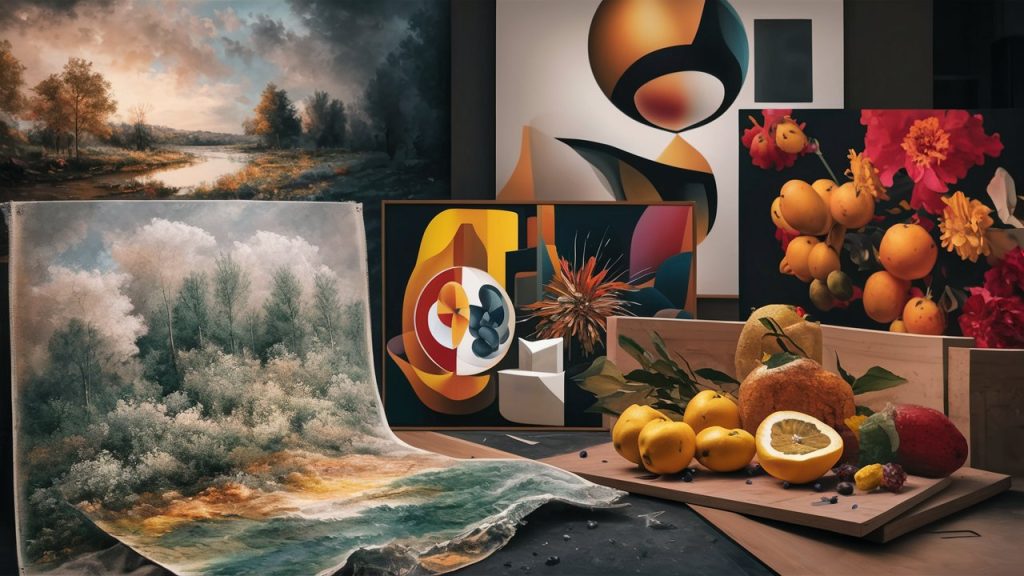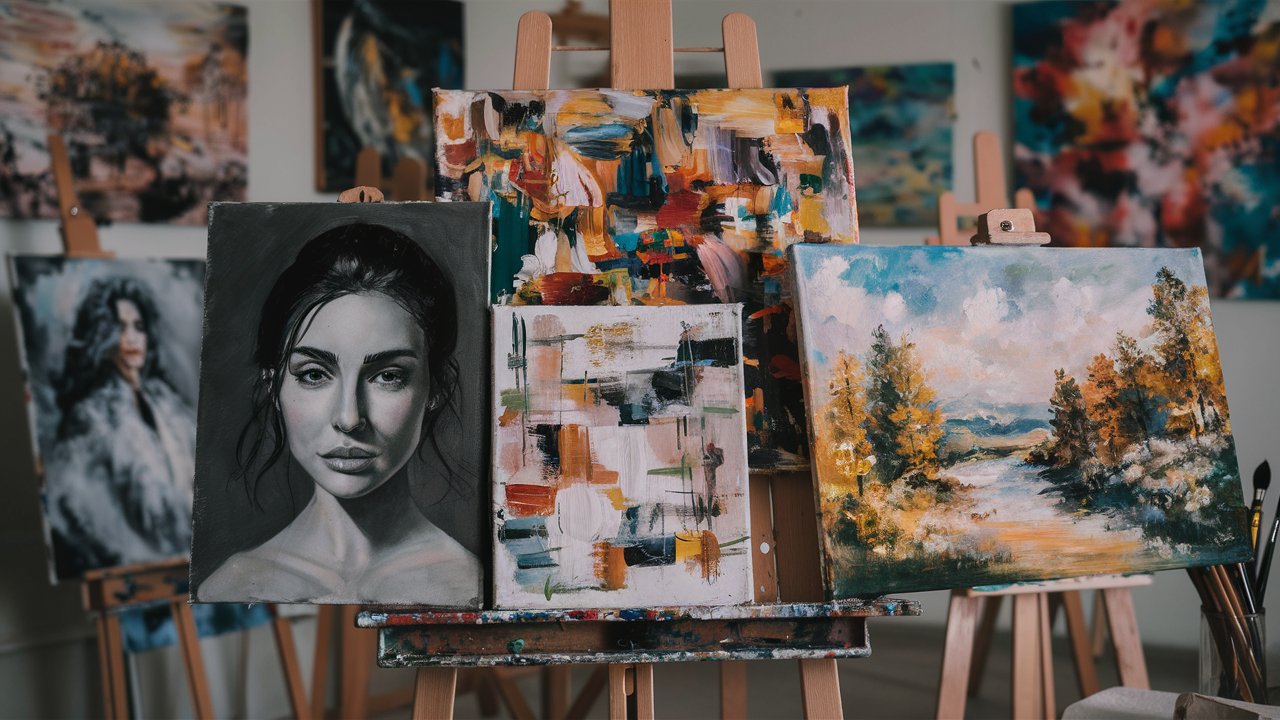Table of Contents
Painting has been a fundamental part of human expression for centuries. Various styles have emerged, from the earliest cave paintings to modern masterpieces, each with unique charm and techniques. Understanding these styles enhances your appreciation for art and allows you to see the world through the eyes of the artists who created them. This article will explore the different types of painting styles, revealing the hidden treasures within the art world.
Classical Painting Styles

Realism: Capturing Life as It Is
Realism is one of the most recognized types of painting styles. Emerging in the mid-19th century, it depicts subjects exactly as they appear in everyday life. Artists who embrace realism aim to create lifelike images, paying close attention to detail, light, and shadow. This style avoids exaggeration and instead seeks to portray the truth, making the ordinary extraordinary. Realism is often seen in portraits, landscapes, and still-life paintings.
Impressionism: The Art of Light and Color
Impressionism is another classical painting style that changed how we see the world. Originating in France in the late 19th century, this style focuses on capturing the effects of light and color rather than details. Impressionist artists like Claude Monet and Pierre-Auguste Renoir often painted outdoors to capture the fleeting moments of sunlight and shadow. Their brushstrokes are loose and visible, giving their paintings a sense of movement and life. Impressionism invites viewers to experience the world as the artist sees it, full of vibrant colors and dynamic light.
Modern types of painting styles
Abstract Art: Breaking Away from Reality
Abstract art is one of the most intriguing painting styles. In this style, the artist breaks away from traditional representation. Instead of depicting objects as they are, abstract artists use shapes, colors, and forms to convey emotions or ideas. This style allows for a great deal of creativity and interpretation. For example, the works of Jackson Pollock and Wassily Kandinsky often leave viewers pondering the meaning behind the seemingly random patterns and bold colors. Abstract art challenges us to see beyond the surface and find meaning in the unknown.
Surrealism: The World of Dreams and Imagination
Surrealism is a types of painting styles that delves into the unconscious mind, blending reality with fantasy. Emerging in the early 20th century, surrealist artists like Salvador Dalí and René Magritte created dreamlike scenes that challenge our perception of reality. This style often features bizarre combinations of objects, strange landscapes, and illogical scenes that seem straight from a dream. Surrealism invites viewers to explore the depths of their imagination and question what is real and what is not.
Contemporary types of painting styles
Pop Art: The Celebration of Everyday Life
Pop art is one of the most influential painting styles in contemporary art. Emerging in the 1950s, pop art draws inspiration from popular culture, including advertising, comic books, and everyday objects. Artists like Andy Warhol and Roy Lichtenstein turned mundane items like soup cans and comic strips into high art, challenging the boundaries between “high” and “low” culture. Pop art is bold, colorful, and accessible, making it a favorite among art lovers of all ages.
Street Art: The Canvas of the Urban Landscape
Street art is a contemporary painting style that transforms public spaces into works of art. Often seen on the walls of cities worldwide, street art is bold, expressive, and sometimes controversial. Artists like Banksy use this style to comment on social and political issues, turning the urban landscape into a canvas for their ideas. Street art is a powerful expression, allowing artists to reach a broad audience and make a statement outside the traditional confines of galleries and museums.
Exploring Cultural types of painting styles
Chinese Ink Painting: The Art of Simplicity
Chinese ink painting is one of the oldest and most revered painting styles, with a history spanning over a thousand years. This style uses black ink on paper or silk, with subtle variations in tone to create depth and movement. Chinese ink paintings often depict nature, such as mountains, rivers, and flowers, and are known for their simplicity and elegance. The focus is not just on what is painted but also on the space left unpainted, which adds to the overall balance and harmony of the piece.
Aboriginal Dot Painting: Stories in Symbols
Aboriginal dot painting is a unique painting style that originated in Australia. This style uses dots of various colors to create intricate patterns and designs, often telling stories or depicting spiritual beliefs. Each dot painting is rich in symbolism, with certain colors and patterns representing different elements of Aboriginal culture. This style is a powerful way for Aboriginal artists to connect with their heritage and share their stories with the world.
Also read: Is the Opera in Paris by Garnier 2nd Empire Style? Unveil Its Grand Secrets
The Importance of Understanding types of painting styles
Enhancing Your Appreciation for Art
Understanding the different types of painting styles enhances your art appreciation. When you know the history and techniques behind a painting, you can see it in a new light. Whether it’s the precise detail of realism, the vibrant colors of impressionism, or the bold statements of pop art, each style offers something unique. By exploring these styles, you gain a deeper understanding of the artist’s intentions and the cultural context in which they worked.
Discovering Your Artistic Style
Exploring various painting styles can also help you discover your artistic style. Whether you’re an aspiring artist or enjoy creating art as a hobby, experimenting with different styles can be a great way to express yourself. You might find that you’re drawn to the precision of realism, the freedom of abstract art, or the storytelling of Aboriginal dot painting. Whatever style resonates with you, it’s a reflection of your unique perspective and creativity.
Embrace the Diversity of types of painting styles

In sum, the types of painting styles are as diverse as the artists who create them. From the lifelike details of realism to the dreamlike worlds of surrealism, each style offers a unique way to see and interpret the world. By exploring these styles, you gain a deeper appreciation for art and unlock your creative potential. The art world is full of hidden treasures waiting to be discovered, and each painting style is a key to uncovering them. Whether you’re an art lover or an artist, embracing the diversity of painting styles is a journey worth taking.




